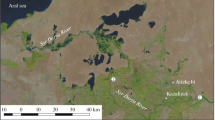Abstract
Research into landscape history makes it possible to follow landscape changes in the past and support landscape management, conservation and restoration programs. Floodplain habitats are lost, isolated and fragmented on account of land use. Nowadays, these habitats are threatened by modifications in the natural water regime, as well as agricultural and forestry practices. Floodplains have great importance because they provide a transition between aquatic habitats and terrestrial biotopes. Our analysis of aerial photographs and topographical maps revealed that the major predicted changes in the study area are related to agricultural abandonment and afforestation. The comparison of land cover maps from 1784 to 2005 showed intensification of agriculture with land cover conversions from arable land and orchards to grasslands, marshes and woodlands. The land use types that are mostly responsible for the fragmentation of the landscape are arable land, economic plantations and orchards. We found that fragmentation was greater after 1956. This was caused by socioeconomic changes and showed that the habitats of floodplains have changed intensively during the last 200 years. Knowledge of this last 200 years of history contributes to a more careful and wiser management of the region through biodiversity protection and environmental development.




Similar content being viewed by others
References
Alados CL, Pueyo Y, Barrantes O, Escos J, Giner L, Robles AB (2004) Variations in landscape patterns and vegetation cover between 1957 and 1994 in a semiarid Mediterranean ecosystem. Landscape Ecol 19(5):543–559
Antrop M (2004) Landscape change and the urbanization process in Europe. Landsc Urban Plan 67(1–4):9–26
Bender O, Boehmer HJ, Jens D, Schumacher KP (2005) Analysis of land-use change in a sector of Upper Franconia (Bavaria, Germany) since 1850 using land register records. Landscape Ecol 20(2):149–163
Costanza R, d’Arge R, de Groot R et al (1997) The value of the world’s ecosystem services and natural capital. Ecol Econ 25(1):3–15
Cousins SAO (2001) Analysis of land-cover transitions based on 17th and 18th century cadastral maps and aerial photographs. Landsc Ecol 16(1):41–54
de Groot RS, Alkemade R, Braat L, Hein L, Willemen L (2010) Challenges in integrating the concept of ecosystem services and values in landscape planning, management and decision making. Ecol Complex 7(3):260–272
Dollar ESJ, James CS, Rogers KH, Thoms MC (2007) A framework for interdisciplinary understanding of rivers as ecosystems. Geomorphology 89(1–2):147–162
Gingrich S, Haidvogl G, Krausmann F (2012) The Danube and Vienna: urban resource use, transport and land use 1800–1910. Reg Environ Change 12(2):283–294
Gutzwiller KJ (2002) Using broad-scale ecological information in conservation planning. In: Gutzwiller KJ (ed) Applying landscape ecology in biological conservation. Springer, New York, pp 357–359
Haslam SM (2008) The riverscape and the river. Cambridge University Press, Cambridge
Hobbs RJ (1993) Effects of landscape fragmentation on ecosystem processes in the Western Australian wheatbelt. Biol Conserv 64(3):193–201
Kohlheb N, Krausmann F (2009) Land use change, biomass production and HANPP: the case of Hungary 1961–2005. Ecol Econ 69(2):292–300
Lambeck RJ, Hobbs RJ (2002) Landscape and regional planning for conservation: issues and practicalities. In: Gutzwiller KJ (ed) Applying landscape ecology in biological conservation. Springer, New York, pp 360–380
Lóczy D, Pirkhoffer E, Gyenizse P (2012) Geomorphometric floodplain classification in a hill region of Hungary. Geomorphology 147–148:61–72
Metzger MJ, Rounsevell MDA, Acosta-Michlik L, Leemans R, Schröter D (2006) The vulnerability of ecosystem services to land use change. Agric Ecosyst Environ 114(1):69–85
Moreira F, Rego FC, Ferreira PG (2001) Temporal (1958–1995) pattern of change in a cultural landscape of northwestern Portugal: implications for fire occurrence. Landsc Ecol 16(6):557–567
Nagaike T, Kamitani T (1997) Factors affecting changes in a landscape structure dominated by both primary and coppice forests in the Fagus crenata forest region of central Japan. J For Res 2(4):193–198
Natura 2000 (2010)—Standard data form, available from http://natura2000.eea.europa.eu/natura2000/SDFPublic.aspx?site=HUHN10008. Accessed 2011
Olsson EGA, Austrheim G, Grenne SN (2000) Landscape change patterns in mountains, land use and environmental diversity, Mid-Norway 1960–1993. Landsc Ecol 15(2):155–170
Priess JA, de Koning GHJ, Veldkamp A (2001) Assessment of interactions between land use change and carbon and nutrient fluxes in Ecuador. Agric Ecosyst Environ 85(1–3):269–279
Riebsame WE, Parton WJ, Galvin KA et al (1994) Integrated modeling of land use and cover change. Bioscience 44(5):350–356
Saunders DA, Hobbs RJ, Margules CR (1991) Biological consequences of ecosystem fragmentation: a review. Conserv Biol 5(1):18–32
Van Dessel W, Van Rompaey A, Poelmans L, Szilassi P, Jordan G, Csillag G (2009) Predicting land cover changes and their impact on the sediment influx in the Lake Balaton catchment. Landsc Ecol 24(7):987
van Dijk T, Kopeva D (2006) Land banking and Central Europe: future relevance, current initiatives, Western European past experience. Land Use Policy 23(3):286–301
Verburg PH, Rounsevell MDA, Veldkamp A (2006a) Scenario-based studies of future land use in Europe. Agric Ecosyst Environ 114(1):1–6
Verburg PH, Schulp CJE, Witte N, Veldkamp A (2006b) Downscaling of land use change scenarios to assess the dynamics of European landscapes. Agric Ecosyst Environ 114(1):39–56
WWF (2002) The Ecological effects of mining spills in the Tisza river system in 2000. http://wwf.panda.org/?3519/Ecological-Effects-of-Mining-Spills-in-the-Tisza-River-System-in-2000. Vienna
Acknowledgments
This research was supported by the NKFP-3B/0019/2002 project, entitled “Hydro-ecology of River Tisza and the Upper-Tisza region” and by the Ányos Jedlik Program—NKFP 6-00013/2005 project, entitled “Interaction of natural and induced ecosystems”. The study was supported by the TÁMOP 4.2.1./B-09/1/KONV-2010-0007 and TÁMOP-4.2.2/B-10/1-2010-0024 projects. We are also thankful to Szilárd Szabó and Gyergely Szabó for their proposals during the computer work. We are indebted to János Tóth and Róbert Enyedi for their help during the field work.
Author information
Authors and Affiliations
Corresponding author
Electronic supplementary material
Below is the link to the electronic supplementary material.
Rights and permissions
About this article
Cite this article
Varga, K., Dévai, G. & Tóthmérész, B. Land use history of a floodplain area during the last 200 years in the Upper-Tisza region (Hungary). Reg Environ Change 13, 1109–1118 (2013). https://doi.org/10.1007/s10113-013-0424-8
Received:
Accepted:
Published:
Issue Date:
DOI: https://doi.org/10.1007/s10113-013-0424-8




